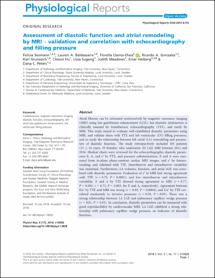| dc.description.abstract | Atrial fibrosis can be estimated noninvasively by magnetic resonance imaging (MRI) using late gadolinium enhancement (LGE), but diastolic dysfunction is clinically assessed by transthoracic echocardiography (TTE), and rarely by MRI. This study aimed to evaluate well-established diastolic parameters using MRI, and validate them with TTE and left ventricular (LV) filling pressures, and to study the relationship between left atrial (LA) remodeling and parameters of diastolic function. The study retrospectively included 105 patients (53 ± 16 years, 39 females) who underwent 3D LGE MRI between 2012 and 2016. Medical charts were reviewed for the echocardiographic diastolic parameters E, A, and e′ by TTE, and pressure catheterizations. E and A were measured from in-plane phase-contrast cardiac MRI images, and e′ by feature-tracking, and validated with TTE. Interobserver and intraobserver variability was examined. Furthermore, LA volumes, function, and atrial LGE was correlated with diastolic parameters. Evaluation of e′ in MRI had strong agreement with TTE (r = 0.75, P < 0.0001), and low interobserver and intraobserver variability. E and A by TTE showed strong agreement to MRI (r = 0.77, P = 0.001; r = 0.73, P = 0.003, for E and A, respectively). Agreement between E/e′ by TTE and MRI was strong (r = 0.85, P = 0.0004), and E/e′ by TTE correlated moderately to invasive pressures (r = 0.59, P = 0.03). There was a strong relationship between LA LGE and pulmonary capillary wedge pressure (r = 0.81, P = 0.01). In conclusion, diastolic parameters can be measured with good reproducibility by cardiovascular MRI. LA LGE exhibited a strong relationship with pulmonary capillary wedge pressure, an indicator of diastolic function. | es_PE |


